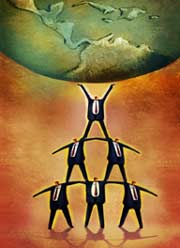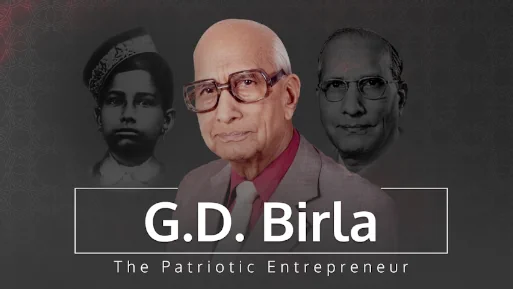Thought leadership through management education
08 September, 2008 | The Economic Times
ShareKumar Mangalam Birla
Chairman, Aditya Birla Group
The Economic Times
8 September 2008
Why has thought leadership become so important at this juncture in history? Every ideology and every system has fallen short, in some way or the other. While capitalism has brought growth and higher standards of living, it has also resulted in periodic instability and often increased inequalities. Socialism brought about greater equality and economic security, but lagged greatly in increasing the size of the pie. Authoritarian states have collapsed, but democracy has also not delivered results, at least quickly enough. So we have to live with huge contradictions: the worst of both worlds.
Thought leaders and thought leadership can broadly be segmented into five categories. The first kind of thought leaders, are those whose thoughts inspire, stoke passion, trigger a process of self-inquiry among the listeners. For instance, Rabindranath Tagore’s dream of an India: “Where the mind is without fear and the head is held high, where knowledge is free; Where the world has not been broken up into fragments by narrow domestic walls”.
Or Churchill who famously said: “Never give in — never, never, never, never, in nothing great or small, large or petty, never give in except to convictions of honour and good sense. Never yield to force: never yield to the apparently overwhelming might of the enemy”.
And the finest text on thought leadership — the Bhagavad Gita. The Gita contains nuggets of knowledge that are invaluable to everyday living, living more fruitfully and optimally. It is much more about philosophy than religion and is universal in its applicability, across religions, cultures and countries. It explains vividly the concept of the mind and the intellect. How one needs to sharpen the intellect to control the mind. Or, how one’s attitude determines one’s altitude, how the past is history, the future is a mystery, the present is a gift, use it optimally by keeping the mind from drifting constantly into the past and the future.
The second kind of thought leadership is when through one’s own analysis and experience, a leader forms a framework of thinking to analyse a situation or to effectively sort data. Many years after it was first expounded, Maslow’s theory of the hierarchy of needs, continues to be an invaluable mental framework for understanding human behaviour and human motives. Porter’s theory of the five forces is perhaps one of the best methods to analyse the attractiveness of an industry and its key value drivers.
Third, are thought leaders who are proponents of an ideology that is contrarian to current thinking. The most striking example, Mahatma Gandhi, who countered the forces of violence with totally non conventional ‘weapons’ — pacifism, moral suasion, fasting.
A recent example is C.K. Prahalad’s bottom of the pyramid concept that explains how to stop thinking of the poor as victims or as a burden and start recognising them as resilient and creative entrepreneurs and value conscious consumers.
 Fourth, are thought leaders who through
Fourth, are thought leaders who through
innovations, c;reate product or services that meet the needs of a consumer class, very often catering to needs that are unarticulated, but help improve productivity and effectiveness. As part of our quality and TQM process every year, we receive suggestions from shop floor workers that are amazingly innovative. It is gratifying to see that some of these suggestions result in crores of savings on an annual recurring basis, without requiring major investments. I believe the worker who has gone beyond the call of duty to find solutions to practical problems in his area of work, is in every way a thought leader.
And fifth, is that thought leadership that is put to use for altruistic purposes. An example that fascinates me is the Jaipur foot organisation which makes artificial limbs for the disabled. It has transformed the lives of millions by providing artificial limbs at an incredibly low cost.
Having etched this background, I offer a few initial deductions. First, thought leadership is not necessarily a result of education, an example of that is G.D. Birla, my great grandfather who, with little formal education himself, was a great educationist and the founder of BITS, Pilani. Another example is that of Dhirubhai Ambani. Second, it is not restricted to a few fields of work or walks of life or to any section of society. It is universal and sector agnostic.
That takes us to the moot question, “does management education foster thought leadership?” I believe that management education and management educators can facilitate thought leadership in a number of ways. The most significant manner is by the way they conceptualise and think about management education itself and the way they prepare their students, through their curriculum, assignments, projects, question papers, methods of evaluation and above all through the insights they bring into the classroom. Also, management educators must believe that management impacts and applies to every area wherever resources are used and therefore, it goes well beyond corporates and industry, and thought leadership across all areas of work. As Professor Donald Haider of Kellogg’s Business School says, “the universe of hospitals and universities, opera and orchestra companies, family service agencies and religious organisations, soup kitchens, environmental advocacies and civil rights organisations” are all a crucial part of our economic, social and civic life. In a situation like this, it is incomprehensible to see management or management education restricted to corporates and industries alone.
Management education can play a role to an extent in providing information, ensuring a minimum development of understanding. But converting that information to knowledge and then intuition, is left entirely to the student.
 Management education usually focuses on building a professional — a brand manager, an investment banker, a financial analyst, or a market researcher. But a thought leader is not just a professional. She is a person who is aware of the context in which she works, is sensitive to society’s concerns, deeply cares about the well-being of all and has an intensely personal point of view about what can and needs to be done. It is the powerful combination of the professional and the person that stimulates thought leadership. You rarely see a thought leader without a deeply human core. Management education represents a unique opportunity in the life of an individual to develop points of view that shape the professional and can potentially shape the type of individual she is.
Management education usually focuses on building a professional — a brand manager, an investment banker, a financial analyst, or a market researcher. But a thought leader is not just a professional. She is a person who is aware of the context in which she works, is sensitive to society’s concerns, deeply cares about the well-being of all and has an intensely personal point of view about what can and needs to be done. It is the powerful combination of the professional and the person that stimulates thought leadership. You rarely see a thought leader without a deeply human core. Management education represents a unique opportunity in the life of an individual to develop points of view that shape the professional and can potentially shape the type of individual she is.
However, my own strong belief is that management education cannot by itself c;reate thought leaders. Management education can play a role to an extent and no further. It provides information, ensures a minimum development of understanding, ensures a whole lot of mental gymnastics. But converting that information, refining it to knowledge and then intuition, is left entirely to the student.
Going further, to be a thought leader is entirely left to the initiative and drive of the seeker, the student. Thought leadership requires passion, commitment to a cause, the conviction in one’s beliefs. It requires the ability to train oneself to become an outstanding leader — through understanding one’s strengths and honing them, and one’s weaknesses and working on them relentlessly. It calls for discipline, and most times for personal sacrifice. It calls for focus, patience. To get to be the best in class, you need to work at it. Daily. Consistently. Passionately.
It entails an attempt to achieve personal mastery. It requires a good human being. Very importantly, it requires facing and letting go of one’s fears and self-limiting beliefs. As Lord Chesterfield said, “it is not possible to discover new oceans, unless one is willing to lose sight of the shore”. All of this calls for personal conviction, stretching beyond imagination, a strong personal desire to make a difference.
Can this be taught through management education? I believe it can’t.
 But there is a crying need for thought leadership — be
But there is a crying need for thought leadership — be
it the fields of polity, bureaucracy, industry, NGOs, media, what have you. It is upon us as a country to work collaboratively and c;reate the social environment and infrastructure to foster thought leadership. It’s time to take charge of one’s own destiny as a country.
Whilst several western economies have begun to age, we in India, have a demographic advantage. From now up until 2050, we will have the largest number of young working people in the world. Can this resource become an advantage for India, if it is bereft of thought leaders? I believe it cannot.






